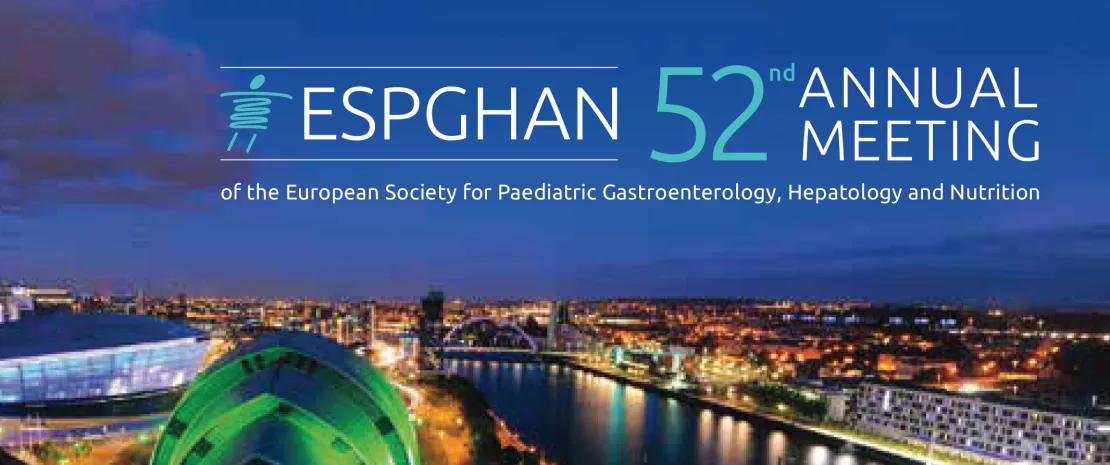ESPGHAN: main contributions on intestinal microbiota in children
Congress review
By Pr. Patrick Bontems
Université Libre de Bruxelles, Brussels, Belgium
Sources
This article is based on scientific information
Sections

About this article
Author
ESPGHAN was created over 50 years ago and organises an annual congress attended by more than 4,000 participants coming from over 100 different countries.
Development of microbiota at birth
Exchanges between the mother and child determine the development of microbiota after birth. Any disruption to these exchanges increases the risk of developing certain disorders.[1] The main causes of dysbiosis induced during the neonatal period are caesarean birth, the use of antibiotics and the absence or premature discontinuation of maternal breastfeeding (before the age of 4-6 months). Given that some indications for a caesarean and a reasonable use of antibiotics cannot be called into question, the promotion of maternal breastfeeding remains a priority for paediatricians.
Several studies presented have strengthened this notion. For example, 267 children were monitored by Sakwinski et al. up to the age of two years. This longitudinal study showed that the risk of suffering a respiratory infection in non-breastfed infants was 3.84 times higher. The protective effect of breastfeeding is due to its modulation of the microbiota, since breast milk encourages the constitution of microbiota with a predominance of Bifidobacteria, as restated by Berger et al. The Berger study analysed stools collected from exclusively breastfed children in the United States, Belgium, Italy, Philippines and Bangladesh. The study showed that the predominance of Bifidobacteria was only present in 17% of infants in the United States, compared to an average of over 70% in other countries. This difference could be due to the composition of breast milk, to maternal microbiota, or to other environmental factors.
The composition of the microbiota of premature babies is disrupted following the separation of the mother and child. Administering breast milk can reduce such disruptions.[2] Thus, the oropharyngeal administration of colostrum stimulates the presence of Bifidobacteria, as shown by Feferbaum et al. In addition, the pasteurisation of colostrum results in an increase in Proteobacteria compared to raw colostrum. In a study conducted by Yamashiro et al. in Japan, the concomitant administration of colostrum and Bifidobacterium breve appeared to increase the colonisation of Bifidobacteria in the digestive tract and improve growth in premature babies.
Human milk oligosaccharides (HMO)
HMOs are the third component of breast milk.[3] HMOs are mainly galacto-oligosaccharides that have an effect on the microbiota.[4] In recent years, infant formulas have been supplemented with certain HMOs.[5] Many studies have been presented on this subject during the congress. For example, Binia et al. reported that the absence - due to a genetic variation - of 2’-fucosylated HMO in breast milk resulted in a higher frequency of respiratory infections. Sprenger et al. reported the findings of a controlled randomised study showing that this protective effect was due to the microbiota being richer in Bifidobacteria. Tomasi et al. studied the cognitive abilities of mice based on the presence or absence of 6’-sialyllactose. The memory and spatial orientation of mice improved when this HMO was present in the feed of young mice.
Faecal transplantation
Faecal transplantation is a therapy used to modulate and restore/rebalance the microbiota of a recipient in cases of dysbiosis. The primary indication recognised at present is refractory or recurrent Clostridium colitis. A Chinese study conducted by Zhang et al. on 11 children reported a 64% efficacy after a single administration, with the other cases improving after 2-3 administrations. In another presentation, these same authors warned against the risk of such transplantations, especially in immunosuppressed patients. Adverse reactions were reported in 25% of patients - reactions that were particularly severe in two cases including one fatality.
Symbioses
The development of symbioses probably offers a more reproducible solution for the future (no donor variation) and is potentially less dangerous than faecal transplantation. During the congress, the benefit of symbiosis was illustrated by a study conducted in Russia by Larkova et al. (food allergies) and by Lin et al. (non-alcoholic hepatic cirrhosis). In the latter study in mice, the authors demonstrated the protective effect of symbiosis in preventing fibrosis and steatosis in high-fat diets. In addition, probiotics alone retain measurable clinical effects. During the congress, a controlled randomised trial versus a placebo arm conducted by Bastruk et al. highlighted the efficacy of a strain of Lactobacillus in improving the symptoms associated with cow’s milk allergy. Nardi et al. restated the efficacy of certain probiotics in reducing the duration of acute gastroenteritis; Moretti et al. showed their effect in reducing the adverse digestive reactions of antibiotics, while Nocerino et al. reported their impact on functional digestive disorders in infants.
Microbiota and digestive tract disorders
Dyspepsia symptoms are very common and proton pump inhibitors often prescribed. Acharyva et al. showed that 60% of children with digestive symptoms suggestive of oesophageal or gastric conditions presented with intestinal fermentation (SIBO). The authors suggest that a glucose test should be performed in the event of a negative gastroscopy in such patients.
Several authors have highlighted the role of the microbiota in Crohn’s disease, cystic fibrosis and lactose intolerance. However, a systematic review carried out by Bezawada et al. failed to demonstrate the role of the microbiota in autism. Equally, Lukasik was unable to demonstrate the link between the neonatal administration of antibiotics and autism.







